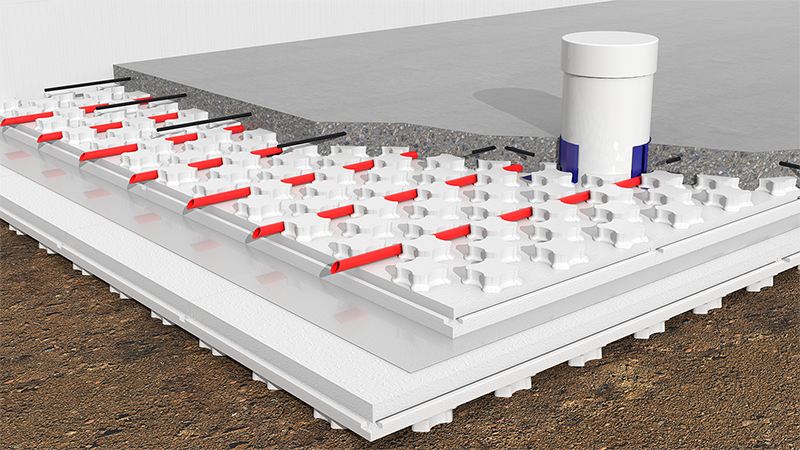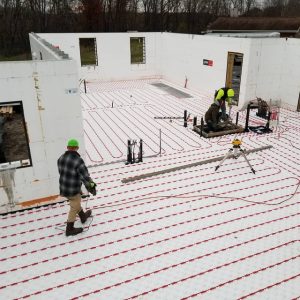You may know Heat-Sheet® as a convenient solution for installing PEX tubes in hydronic radiant floors. But did you know that Heat-Sheet® also makes for an effective under-slab radon mitigation insulation layer when installed a certain way?
In the post below, we’ll explain how to get the double benefit of Heat-Sheet® by using it as both a radon mitigation layer and under slab insulation.
What is Radon?
Radon is an odorless, colorless, and tasteless noble gas that appears as Uranium breaks down deep in the soil and bedrock. As a byproduct of the Uranium breakdown process, Radon is highly radioactive and harmful to the health of humans and animals.
As Radon gets produced, it rises through the soil, penetrates the foundations of any buildings in its path, and accumulates inside. Unfortunately, Radon is omnipresent in North American soil, and is particularly prevalent in the US Midwest.


Why Does Radon Need Mitigation?
Radon needs mitigation in residential buildings because it’s harmful to human health.
Radon’s radioactive properties damage the lung cells of anyone who breathes in air containing large volumes of the gas. With this damage, the lung cells are highly vulnerable to cancer.
In fact, Radon exposure is the number one cause of lung cancer in non-smokers
How Is Radon Usually Mitigated?
Usually, Radon is mitigated by applying a layer of 6-mil polyethylene beneath the slab and over top of a 4” layer of clean granular material.
The poly layer creates an obstacle in Radon’s path, and the gas then traverses through the granular layer beneath the slab until it reaches a specially installed Radon vent pipe.
The use of a granular layer in this application is common-place but it isn’t a perfect mitigation layer for Radon.
Over time the granular can settle and Radon could eventually find itself trapped in pockets with no way out.
And as well, the granular layer does not provide any insulation which is usually desired under slab.
And finally, HVAC contractors can find it inconvenient and labor intensive to work around the granular layer on site.
Despite these deficiencies, gravel has been the go-to way of mitigating Radon and channeling it to the vent.
Until now.
How Heat-Sheet® Heavy Panels Help To Mitigate Radon
Heat-Sheet® panels, including the Heat-Sheet® Heavy series, were originally designed to insulate a concrete slab and accommodate PEX tubing for hydronic radiant floor heating systems.
The Heat-Sheet® system comprises EPS insulation panels with pre-molded nodules that are laid out in a grid pattern. These nodules make it fast and easy to install the PEX tubing — all you have to do is walk the tubing into place.
As it turns out, though, Heat-Sheet® Heavy is just as useful when placed with its “nodules down” as it is with the nodules up.

When installed beneath a slab with the nodules facing down, Heat-Sheet® Heavy will allow Radon to flow to a venting pipe beneath the slab with up to 50% greater efficiency than the commonly-used granular layer. Thus, Heat-Sheet® Heavy panels will serve two purposes when installed nodules-down:
- Provide underslab insulation: The EPS insulation that makes up the Heat-Sheet® Panel provides R-values that range between R-8 and R-16, depending on the thickness of the panel you use.
- Replaces under-slab gas permeable layer: Used instead of a granular layer, Heat-Sheet® Heavy acts as the permeable layer that lets Radon escape from beneath the slab to a special venting pipe.
And, if the building is designed with hydronic radiant floors, a second layer of Heat-Sheet® can be installed with nodules up on top of the first one to accommodate the PEX tubes. All you’ll need is a Radon Barrier (usually 6 mil poly) in between the two Heat-Sheet® layers.
How to Install Heat-Sheet® Heavy As A Under Slab Radon Mitigation Insulation Layer
(Refer to the the Under-Slab Radon Mitigation Insulation Layer Installation Guide for the complete instructions)
- Level and compact the base material, as required.
- Install Heat-Sheet® Heavy, “nodules down”, on the base material. Heat-Sheet® Heavy acts as the sub-slab ventilation layer, so no additional gas permeable layer, such as granular fill, is required.
- Since Heat-Sheet® Heavy panels interlock, taping joints is not required.
- Cut a circular hole in the foam layer with a hole saw or utility knife to accommodate the radon exhaust pipe.
- Apply spray foam between Heat-Sheet® Heavy and the exhaust pipe for gaps 1/4” or greater.
- Install an air and vapor barrier layer on top of Heat-Sheet® Heavy, such as 6 mil polyethylene sheets or a peel-and-stick membrane.
- Provide a minimum 12” lap joint, or as required by local codes or by design. When using 6 mil polyethylene sheets, seal and secure lap joints with low permeance sheathing tape.
- Cut a hole in the air/vapor barrier to accommodate the exhaust pipe.
- Seal between the air/vapor barrier and the exhaust pipe with a low permeance sheathing tape or mastic sealant.
- Seal the perimeter with acoustic sealant between the air/vapor membrane and the foundation wall, grade beam or slab.
- Pour the slab
And you’re done!

Don't miss a thing!
Subscribe for exclusive content, insider industry news and limited edition webcasts.
Wrapping It Up
Radon is a harmful gas that poses a serious health hazard to households across much of North America.
And while traditional Radon mitigation measures comply with current codes, there is a better and more efficient way.
Heat-Sheet® Heavy — when installed “nodules down” — creates the perfect mechanism for channeling Radon to the venting pipe.
And as an added benefit, Heat-Sheet® Heavy also effectively insulates your slab!






